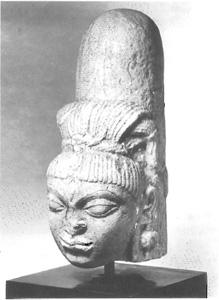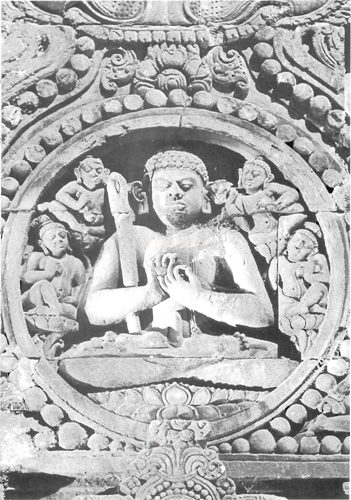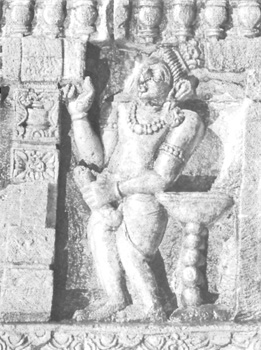2
SYMBOLISM
THE IMAGE OF THE WORLD'S CREATOR
The means by which a male infant is distinguished at birth is his sex organ. It is why the masculine organ is called in Sanskrit lingam—a word that implies "sign."
"The distinctive sign by which one can recognize the nature of something is therefore called lingam" (Linga Purāna, 1.6.106).
The principle from which the universe has issued is formless, without lingam, without a distinctive sign.
"Shiva (the supreme divinity) is without sign (without sex), without color, without taste, without odor, beyond the reach of words or touch, without qualities, immutable and immobile" (Linga Purāna, 1.3.2-3).
Absolute being, not being manifested, can be perceived only by means of its creation, which is its sign—its lingam. The existence of a transcendent being who thinks the world can be known only through this sign. The lingam, or phallus, the source of life, is the form by which the Absolute Being, from whom the world is issued, can be evoked.
"We revere in the sun the dispenser of light, the sum of all eyes; it is in the same regard that in the phallus we worship Shiva who is present in all generative power. It is not one particular eye that we venerate and make images of, but the sun, the complete eye that gives us sight, the sun that is the source of all visibility. In the same regard it is Shiva, the total being, who is revered in the phallus, his symbol" ("Lingopāsanā Rahasya," Siddhanta, vol. 2, p. 154).
"By worshiping the lingam one is not deifying a physical organ, but simply recognizing a form that is eternal and divine manifested in the microcosm. The human organ is the image of the divine emblem, the eternal and causal form of the lingam, present in all things. The phallus is the perceptible aspect of the divinity who exceeds the state of noncreation by the width of ten fingers" (Purusha Sūkta).
In the microcosm, which is to say in man, the sexual organ, the source of life, is the form in which the nature of the formless manifests itself. However, "it is not the phallus in itself which is revered but that for which it is the sign—the progenitor, the cosmic individual. The phallus is the emblem, the sign of the individual Shiva for whom it is the symbol" (Shiva Purāna, 1.1 6.106–7).
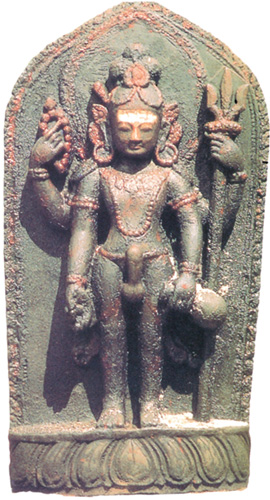
Nepal: Ithyphallic Shiva, seventeenth century. Kathmandu. Photograph by Ira Landgarten from James Wasserman's Art and Symbols of the Occult (Destiny Books).
"The symbol of the cosmic man Purusha, the archetype, the universal plan present in all things, is the male emblem, the phallus. The symbol of energy, which is the world's substance, the generator of all that exists, is the female organ, the yoni" ("Lingopāsanā Rahasya," p. 154).
THE SYMBOL OF THE UNIVERSE
In the being without form within which exists no distinctive sign appears a sign which is the Universe. This sign can be mentioned, touched, breathed, seen, and tasted. It is the source of both coarse and subtle elements" (Linga Purāna, 1.3.3–4).
"Fundamental Nature is therefore called phallus. He who possesses this distinctive sign is the supreme being" (Linga Purāna 1.17.5).
"The lingam has its roots in the formless, in the nonmanifested (avyakta). Shiva is therefore in himself without the lingam. The lingam is the thing-of-Shiva" (Linga Purāna 1.3.3–4).
"Shiva, as an indivisible causal principle, is worshiped under the form of the phallus. His different manifestations within the created world are represented by anthropomorphic images. All the other gods form part of the multiplicity and are therefore represented by images" ("Shrī Shiva Tattva," Siddhānta),
India: White crystalline sandstone Shiva lingam, circa fourth century. Photograph by Nik Douglas
"In the hierarchy of the created, it is the sun that appears as the progenitor of the terrestrial world. It is the image of the creator, which is why its symbol is the organ of procreation" (Shiva Purāna, 1.16.105).
"Shiva said: I am not distinct from the phallus. The phallus is identical to me. It draws my faithful close to me; therefore it must be worshiped. My beloveds! Everywhere an erect penis is to be found I am present, even if it is no more than another of my representations" (Shiva Purāna, 1.9.43–4).
"The entire world has the phallus as its foundation. All is issued from the lingam. He who desires perfection of the soul must worship the lingam" (Linga Purāna, 1.3.7).
"It is the lord who is the source of all pleasure.... For existence to be a perpetual joy, the faithful should worship the phallus, which is Shiva himself We venerate the sun which gives birth to the world and sustains it as the symbol of the origin of the terrestrial world. In the same regard, it is under the form of the phallus that Shiva, the universal principle, should be revered. This is why the male principle is recognizable as that which is called phallus. The phallus is the symbol of the god" (Shiva Purāna, 1.16.103–6).
THE MAHĀ-LINGAM, OR TRANSCENDENT SIGN
Purusha, the cosmic man (the ideational principle of the world) and Prakriti, Nature (the universal substance) are one and yet distinct and, even though distinct, inseparable. They exist only by their relationship to each other. From the perspective of principle, they form part of manifestation; from the perspective of the world, however, they exist before creation. It is their nondivisible state, the stage at which the sign, the lingam, is still united to that which is without sign (alingam), which is called the transcendental sign: the Mahā-lingam. It represents the independent divinity (niralamba) beyond change (nirvikāra)" (Gopinātha Kavirāj, "Linga Rahasya," Kalyāna, Shiva anka, p.476).
"Universal Consciousness, which is the first stage in the order of creation, is called mahat, the 'great principle.' It forms the womb in which I deposit my semen. From it comes, according to the hierarchy of creation, all elements and all creatures" Bhagavad Gītā, 14.3).
"To the Latin philosophers and mythographers, the god Pan, represented by Priapus, is the symbol of the Whole, of the Universe. In the Orphic litanies, Pan is the first principle of love, the creator incorporated into universal matter. Sky, earth, fire, and water are its limbs" (Payne Knight, The Worship of Priapus, p. 13).
DIVINE EROS
Within the immutable causal being first appears desire, the desire to procreate. "He will desire. May I procreate! May I exist for always!" (Taittrīya Upanishad, 2.6.1). In Greece, Eros is always associated with Himeros, desire.
"Desire, the attraction of opposites, is the first manifestation of dualism; it gives birth to the distinction between the person and Nature. Tied to Nature by desire, the cosmic person procreates countless worlds. This desire, this inclination to pleasure, that makes up part of his nature, is supernatural Eros" (Karpātri, "Lingopāsanā Rahasya," p. 153).
"Desire forms part of the universal Being, which is present in all things" (Bhāgavata Purāna, 10.55.1).
"Born from the primordial egg, Eros was the first of the gods; none of the others could have been born without him. Born before Aphrodite, he is the origin of all species of plants and animals. He is responsible fur the union of Heaven and Earth.
"To Orphism, Eros Protogonos, the primordial principle of Eros, appeared at the same time as the Ether, which is to say at the beginning of the world. Child of time (Kronos) and necessity (Anagyn), he acts upon inert matter (Chaos), eternally engendering.
"In the Orphic hymns, Eros is the 'father of the night,' attracting light unto himself. He penetrates the world by the movement of his wings. He is called the Magnificent, the Sovereign, Priapus, the Illuminated One" (Payne Knight, The Worship of Priapus, p. 9).
"[Eros] was a wild boy, who showed no respect for age or station but flew about on golden wings, shooting barbed arrows at random or wantonly setting hearts on fire with his dreadful torches.... His most famous shrine was at Thespiae, where the Boeotians worshipped him as a simple phallic pillar—the pastoral Hermes, or Priapus, under a different name" (Robert Graves, The Greek Myths, I.15.1).
THE PHALLUS, ORGAN OF BLISS
From the mystical Shaivite perspective, as in the Dionysian orgy, erotic ecstasy is only secondarily a means of reproduction. Above all it is a search for pleasure. In erotic rituals, "to please the lord his symbol must be worshiped independently of its physical function. As this function is to give birth, that function is thereby excluded" (Shiva Purāna, 1.16.108).
The union of Shiva and his lovers—Shakti, Pārvatī, or Satī—is not procreative. Their respective infants are engendered separately. Skanda, the god of beauty and the head of the army of gods, was born from the sperm of Shiva, which fell into the mouth of a sacrificial fire and then into the waters of the Ganges. Ganapati, the elephant-headed god who is prayed to at the start of all endeavors and who protects the entrance to the home, is the son of a goddess who formed him from her skin's flakings while she bathed.
India: Bhuvaneshvar, Temple of Mukteshvara. Shiva and his "avatara" of Lakulisha, tenth century.
"According to the Sefer Yezirah, the phallus fulfills a function that is not only generational but confers equilibrium in regard to the structures built by man and the order of the world. For that reason the connection was established between this 'seventh member' and the righteous seventh day of creation. Under various representations it designates the creative force and it is worshiped as the very source of life" (G. C. Scholem, Les Origines de la Kabbale, pp. 164—65).
Pleasure, in the Shaivite conception, is the image of the divine state. This is why, when the divine manifests itself in its procreative aspect, it shows its aspect as pleasure in equal degree. The sexual organ therefore has a double role: the inferior one of procreation and the superior one of contacting the divine state by means of the ecstasy caused by pleasure (ānanda). The orgasm is a "divine sensation." So whereas paternity attaches man to the things of the earth, the ecstasy of pleasure can reveal divine reality to him, leading him to detachment and spiritual realization. "The phallus is the source of pleasure. It is the sole means of obtaining earthly pleasure and salvation. By looking at it, touching it, and meditating on it, living beings are capable of treeing themselves from the cycle of future lives" (Shiva Purāna, 1.9.20).
"Pleasure's center resides in the sexual organ (upastha), in the cosmic lingam, source of all orgasmic joy. In the terrestrial world, all love, all sensuality, every desire is a quest for that pleasure. We desire things only insofar as they can procure for us sensual bliss. Divinity is only a love object when it represents an unmitigated sensual pleasure. Other things are merely the objects of a temporary love, because they can bring only fleeting satisfactions.
"Lustful desire for women exists only because one sees within it the form of one's own pleasure and the source of enjoyment. The joy of possession momentarily tames the suffering of desire, and man can then experience the pleasure that is his desire's target. Within that pleasure he perceives his own essential nature, which is joy.
"Every orgasm, every pleasure is a divine experience. The entire universe springs forth from enjoyment. Pleasure is at the origin of all that exists. But the perfect love is that whose object is limitless. It is that love which is pure love, love of love itself, the love of the transcendental being-of-sensual-pleasure" (Karpatri, "Lingopāsanā Rahasya:' p.153)'
BĪJA, THE SEMEN
Sperm is the essence of life, the best of oblations, the purest form of sacrificial elixir (soma). All beings are born from an offering of sperm hurled into the fire of desire. There is a representation of Agni, lord of fire, drinking the sperm that gushes out from Shiva's phallus.
India: Temple of Gyaraspur. Bas-relief knoum as "sperm sacrifice on the domestic altar," eighth century.
Sperm is worshiped under various names. It fills the cup of the moon worn by Shiva on his forehead. It is the Ganges flowing from the head of the lingam. All forms of oblation and all beverages that give life or immortality are represented as forms of Shiva's sperm.
Sperm is called bīja (the semen), soma (the oblation), chandra (the moon), and virya (the virile essence). "In Egypt the sun god Re-Atum-Khepri manufactured all of creation by masturbating" (Mircea Eliade, Histoire des croyances et des idées religieuses, p. 101).
The sex organ is that mysterious organ through which the creative principle is manifested by giving birth to a new being. It is therefore the organ by which that principle is visibly represented in every particular species. Sperm, which potentially contains the entire ancestral heritage, race, and characteristics of the person to be, is called bindu (point limit). Indeed, it is the minute passage between being and nonbeing. The sex organ is thereby that organ by which communication is established between man and the creative force, the manifestation of the divine being.
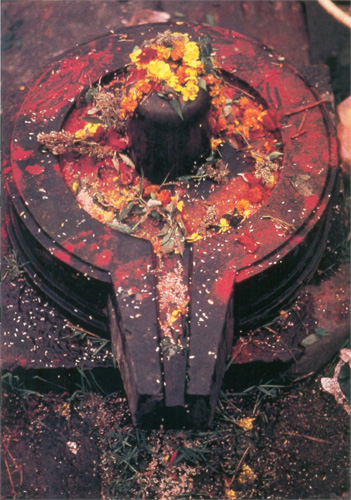
Nepal: Shiva lingam with pilgrims' offerings. Kathmandu. Photograph by Kevin Bubriski.
Within the microcosm, which is to say within man, the design is contained within the semen and becomes real only through the matter that nourishes it within the belly of the mother—the egg, which is the departure point of all living things.
Ritual offerings of sperm were part of agrarian rites in various civilizations. Even today, in certain regions of Africa, young men of various tribes dig holes in the earth into which to pour their sperm. In Hindu rites, except in the case of certain tantric practices, symbolic substitutes for sperm are used, such as rainwater and the seeds of rice or grains. "Since the fluid semen came to be identified as the generic cause of fertility, it may well be that the identification of the sky as male, moistening and fertilizing a female earth, which appears in the oldest layers of so many literatures, took place during the very early stages of agriculture" (Philip Rawson, Primitive Erotic Art, p. 50),
In alchemy, the origin of which is Shaivite, mercury corresponds to the moon, Shiva's cup of sperm. In tantric ritual the lingam is consecrated with mercury. To the Chinese, who call it liquid silver, mercury represents sperm, water, kidneys, blood, and the dragon. The alternation of mercury with cinnabar corresponds to yin and yang.
In Egypt and Greece, as in India, ritual phalluses are painted with cinnabar. In Western alchemy metals are believed to be produced by the underground conjunction of mercury, considered as feminine semen, and sulfur, considered as masculine semen.
"The semen of Shiva and his lover Satī fell upon the back of the earth and filled the world. It is that seed which caused the appearance of every phallic emblem of Shiva that can be found in the infernal regions, the Earth, and Heaven. From it all past and future emblems of Shiva are made. Shiva's lingam issued from the radiation of two semens" (Nārada Pañcharātra, 3.1).
THE VULVA (YONI)
In the sanctuary where it is worshiped, the lingam is represented surrounded by the female organ, the yoni.
"Universal energy, the substance of the world, is represented by the yoni, which grasps the lingam. It is only when the phallus, the giver of semen, is surrounded by the yoni that God can manifest and the universe appear.
"The symbol of the cosmic man, Purusha, the formless, the immutable, the all-seeing eye, is the masculine emblem, the phallus. The symbol of the energy that is the world's substance, generator of all that exists, is represented by the female organ, the yoni" (Karpātri, "Lingopāsanā Rahasya," p. 154). "The yoni represents the womb of the visible and the subtle world" (Yajur veda, Vājasenīya Samhitā, 13.3;
Taittirīya Samhitā 4.2.8.2), "the universal womb in which all things that are individual develop" (Shvetāshvatara Upanishad, 5.55).
The phallus fertilizes that womb. The semen giver is the phallus; it fertilizes Nature, giving birth to the visible world and to the multiple forms of life.
"Because it is the origin of all life. nature is comparable to a womb" (Shiva Purāna, 1.16.101).
"This womb is Nature, the base of all existence. He that sports with her is Shiva. It is he who dispenses pleasure. There is not nor has there ever been any other dispenser" (Shiva Purāna, 1.16.101).
As the universal fertilizing principle the phallus is unique. But every form of existence requires a different womb to be fertilized. That is why all the different species are called wombs, or yoni. The Purānas speaks of 8,400,000 yoni, or different species residing on the earth.
The principle called Shiva represents the totality of procreative power to be found in the universe. All individual procreation is a fragment of it.
"The universe is the issue of the relationship between a masculine and a feminine principle. Everything, as a result, carries the signature of the lingam and the yoni. It is the deity who, in the form of the individual phallus, penetrates each womb and procreates all beings" (Karpātri, "Lingopāsanā Rahasya," p. 163).
"It is he alone who actually penetrates every womb" (Shvetāshvatara Upanishad, 5.2)
The very name Delphi stems from delphys: womb.
THE UNION OF THE SEXES
In the state preceding embodiment, the gods form but one sole being; there is no perceptible duality, no positive or negative force. But from the moment that the first tendency towards manifestation appears in the nondifferentiated substratum, duality is already present. This duality has the character of two poles of opposite attraction—one of positive tendency, the other negative—which are manifested throughout creation under male and female aspects. There is no possibility of creation without the union of opposites. Nothing can issue from either Shiva or Nature alone. For creation to take place, the union of an active and a passive principle, a male organ and a female organ, is indispensable. The union of the cosmic person and universal Nature is represented by the copulation (maithuna) of Shiva and the goddess.
Transcendental virility is the immanent cause of creation. Transcendental femininity is its efficient cause. These principles, in the microcosm, are especially apparent in the reproductive organs, which represent the essential physical function of all living beings. In nature everything pivots on reproduction and is made to assure the continuity of life. It is in the union of the lingam and the yoni that divinity, the power to create, becomes visible in man. Procreation is impossible without such a union. and divine manifestation is equally so without its cosmic equivalent.
The rituals that provide the means for us to communicate with the gods are interwoven with the act of making love.
"The first appeal is the invocation of the god (hinkāra).
"The invitation represents the laudes (prastāra).
"Sleeping next to the woman is the magnificat (udgītha).
"Facing one another is the choir (pratihāra).
"The orgasm is the consecration.
"Separation is the closing hymn (nidhāna).
"He who understands that every sexual act is a hymn addressed to Vama-deva, the fiery form of Shiva, recreates himself with each copulation. He will thrive all the days of his life; he will live long and become wealthy in both offspring and in livestock; rich will be his renown" (Chāndogya Upanishad, 2.13.1).
In Celtic mythology there is "the powerful Fergus mac Roich, 'Fergus son of Great Horse', the name itself being suggestive of virility. ... His penis is described as being seven fingers in length; he mates with the divine queen Medb, 'Drunk Woman', whose own sexuality is boundless" (Anne Ross, in Primitive Erotic Art, p. 83).
The transmission of the genetic code and its transplanting into a rigorously selected soil, the transfer to a new being of an ancestral heritage containing the archetypes bequeathed it by divine thought, is the most important religious act of a man's life. It must be practiced as a ritual, following rules that take into account the most favorable moments and the convergence of the stars, in such a way that the new flame-bearer is suitably adapted to his role and that the breed fashioned by the long line of ancestors continues and neither is degraded nor dies out in the course of its journey. All religions accord a central role to the act of reproduction in its moral code, even if at times they have lost the true meaning of it and reversed its values. Sexual diversion under any of its myriad forms is not to be condemned, so much as the progeny of ill-matched couples, the blending of breeds or races who deform the model drawn by the gods and transmitted by the ancestral lineage.
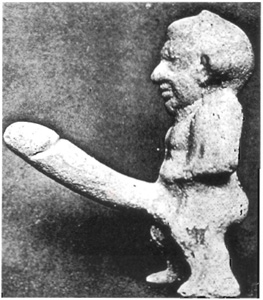
Greece: The ithyphallic god Ben. Photograph from Rufus Camphausen's Encyclopedia of Erotic Wisdom (Inner Traditions).
Procreation's rituals are described in the Tantras. They include adoration of the genitals as images of the divine principles poised to unite to accomplish the miracle. No longer to view in these organs this image of the divine principle or to revere them as such constitutes the first step toward moral decadence and the degradation of the species.
Only through sexual union are new beings capable of existing. This union, therefore, represents a place between two worlds, a point of contact between being and nonbeing, where life manifests itself and incarnates the divine spirit. The forms of the organs that achieve this ritual are symbolic. They are the visible form of the creator.
Everything in all living beings—human and animal as well as in the plant kingdom—is centered on the procreative organ. Man is merely the "phallus-bearer" (linga-dhara), the servant of his sexual organ. The idea of God the father is a puritanical transposition of the divine phallus. The father is someone whose sexual organ pours semen into a receptacle, the argha, or vagina.
To Freud, the phallus signified this aspect ofsexuality that could not be claimed by the individual.
Shiva and his energy, Shakti, envisioned as the source of all manifestation, are symbolized by the procreative organs. The possessor of the phallus represents the unmanifested stage, which remains unknowable. In a less abstract symbolism, the unknowable entity, whose sign is the phallus, can be replaced by the father, the phallus bearer. The total Being, the entity for whom creation is sexual bliss and for whom the phallus is a symbol, is indeed at times called the father.
"O Son of Kunti! Beings born of every womb come from the womb of Immensity, and I am the father, the semen giver."
"I am the father of this world" (Bhagavad Gītā, 14.4; 9.17).
"Like a father and a mother, the Being who thinks the world and the matter in which it is realized gives birth to all the forms of existence. In this world, the men who desire progeny impregnate women. In the same fashion, the Supreme Being, desiring a progeny, desiring to multiply itself, impregnates Nature" ("Lingopāsanā Rahaysa," p. 153).
It is the function that is both important and permanent. The individual who achieves this duty, who carries the organ, is merely its temporary and interchangeable instrument. The tendency to replace the symbol—the procreative organ—by the figurative image of the father is a substitution that allows the intervention of useless anthropomorphic elements, which diminish the degree of abstraction the divine aspect represents.
For Freud, "sexual reproduction made the individual into a contingent carrier, truly the appendage of the genetic code. The discovery of the phallic phase is equivalent to the recognition of the symbolic order's supremacy in relation to the real and the imaginary ... the anteriority of the signifier in relation to the signified."

